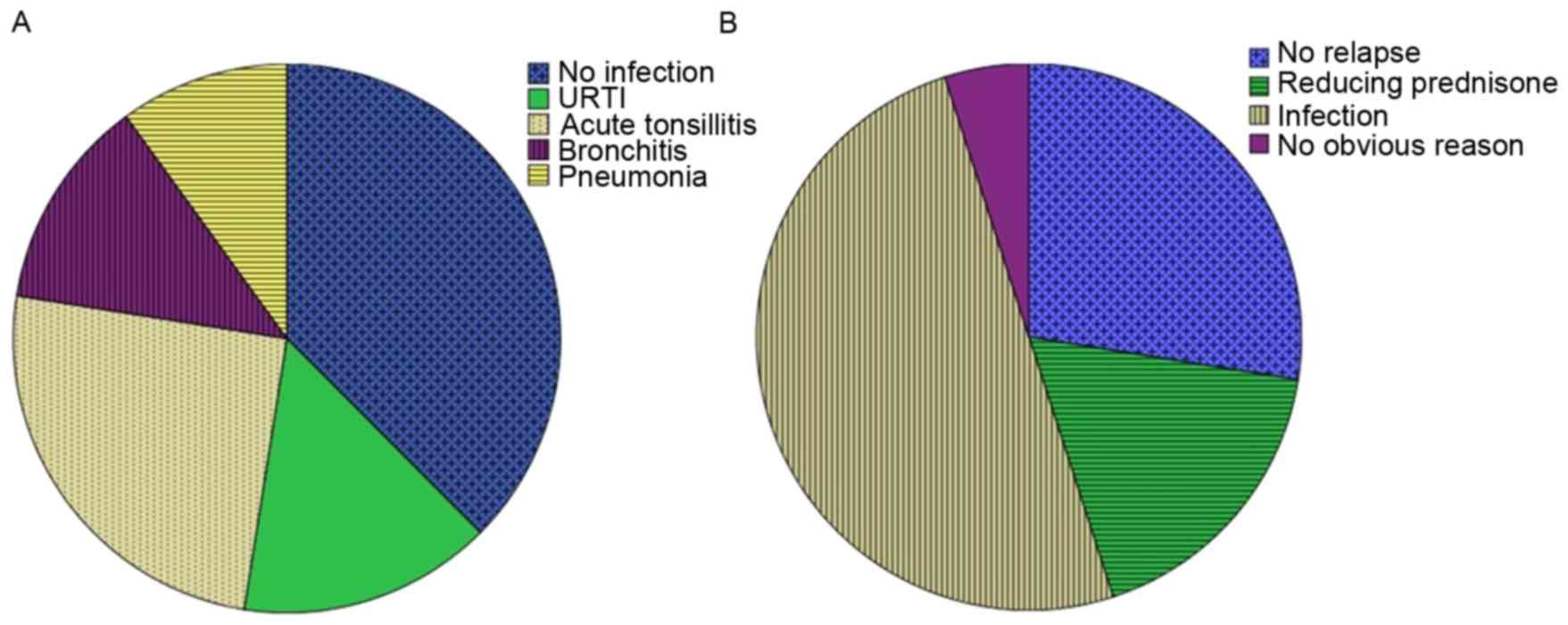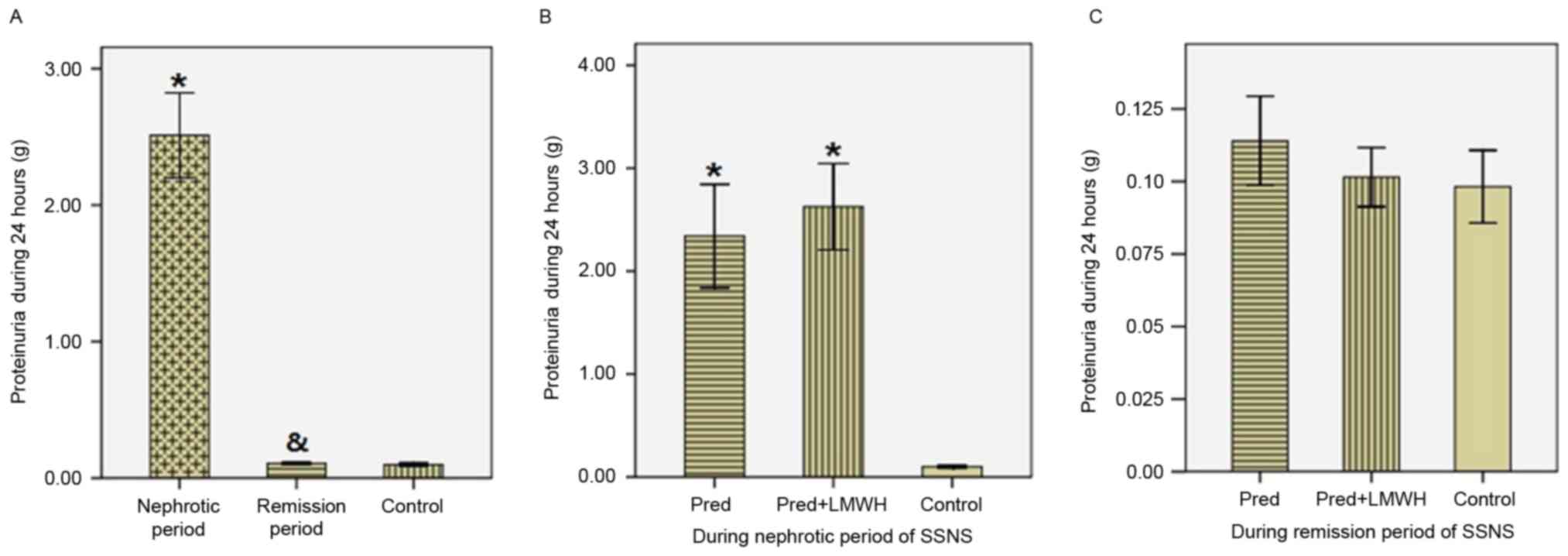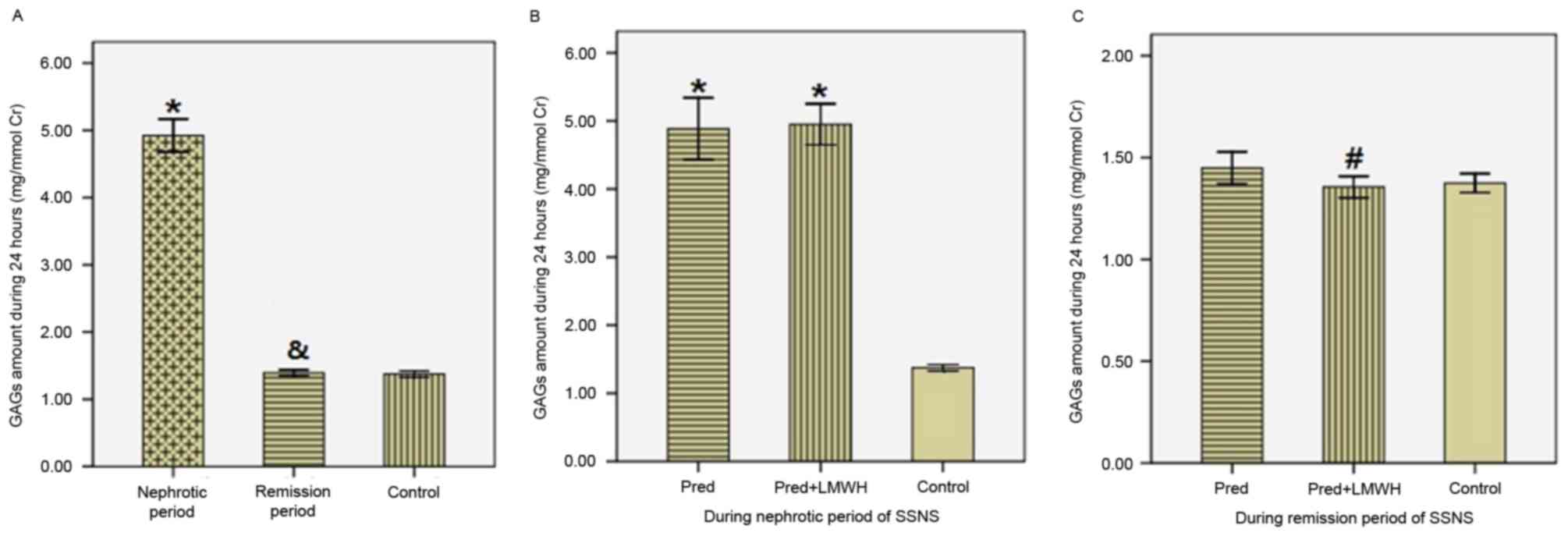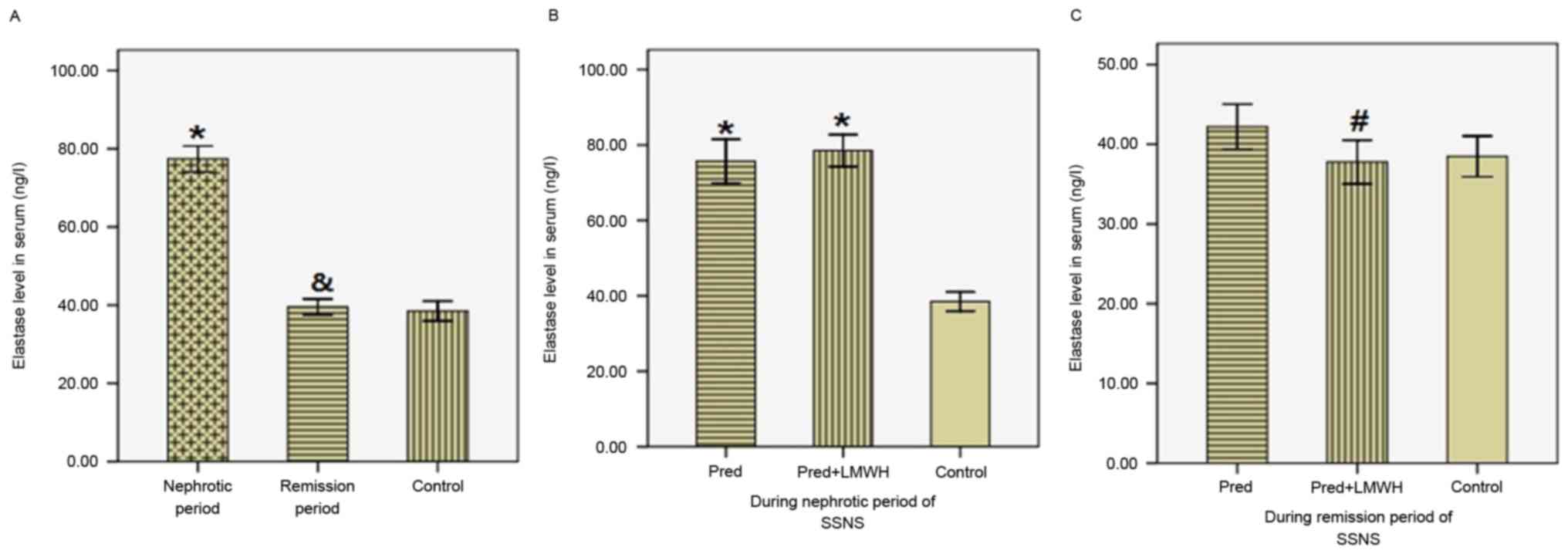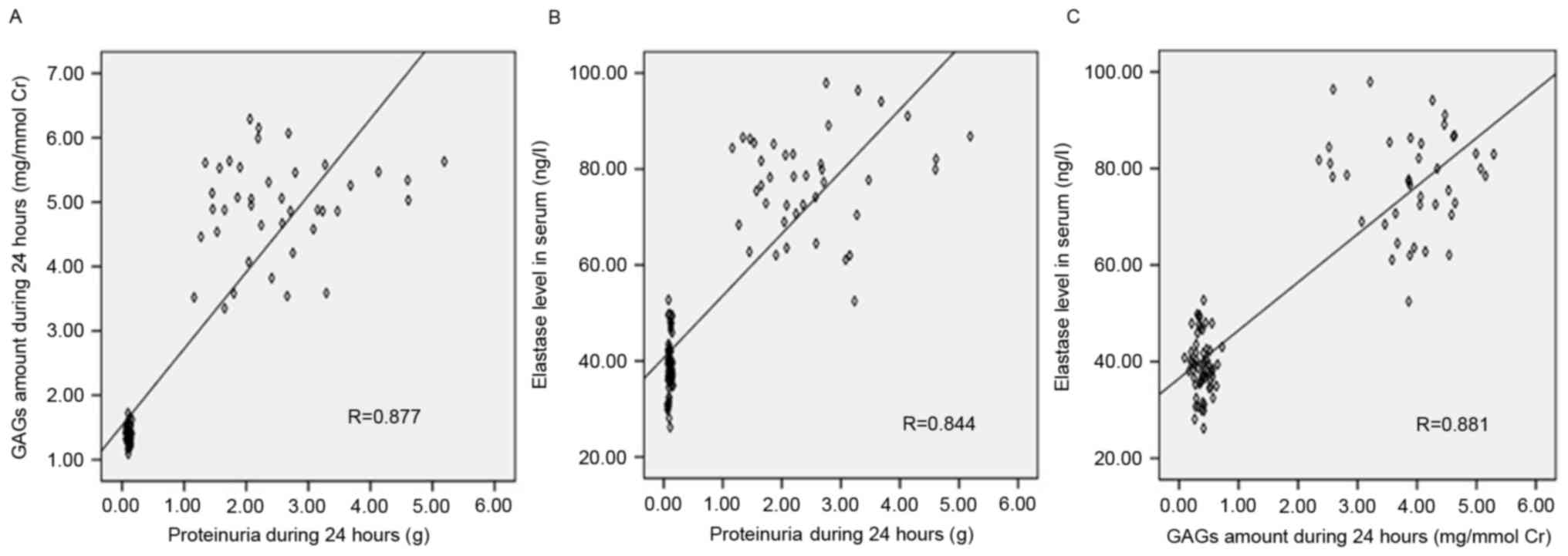Low molecular weight heparin may benefit nephrotic remission in steroid‑sensitive nephrotic syndrome via inhibiting elastase
- Authors:
- Published online on: October 3, 2017 https://doi.org/10.3892/mmr.2017.7697
- Pages: 8613-8618
-
Copyright: © Zhai et al. This is an open access article distributed under the terms of Creative Commons Attribution License.
Abstract
Introduction
Primary nephrotic syndrome (PNS) is a common renal disease in children. The majority of cases are steroid-sensitive (SSNS), the prognosis of which is good; however, patients are prone to relapse (1). The pathogenesis of PNS remains unclear; however, dysfunction of the charge-selectively of the glomerular basement membrane (GBM) may contribute to proteinuria (2). The anionic filtration of the GBM involves glycosaminoglycans (GAGs), particularly heparan sulfate proteoglycan (HSPG), a highly anionic molecule that regulates the charge- and size-selective aspects of glomerular permselectivity (3). GAGs are linear polymers of repeating amino sugar uronic acid disaccharides produced by and associated with the majority of mammalian cells and certain bacterial cells (4). GAGs may interact with numerous proteins and participate in matrix organization, cell adhesion, differentiation, growth, apoptosis and mouse kidney development (5,6). Certain studies have demonstrated that reduced GAGs content in the GBM results in increased passage of proteins across the GBM, particularly negatively charged proteins (7,8). Urinary GAGs levels have been suggested as a marker of glomerular damage in PNS (9,10). GAGs in the GBM may be degraded by certain proteinases, including heparanase or elastase (Ela) (11). Klebanoff et al (12) revealed that Ela may degrade subendothelial matrix HSPG in vitro, which may be involved in proteinuria. By contrast, studies have demonstrated that proteinuria may be alleviated via the administration of GAGs (13–15). Low molecular weight heparin (LMWH) is a negatively charged glycoprotein due to N-sulfate and O-sulfate on the carbon chain and has a similar structure to HSPG. Previous studies have revealed that the anti-inflammatory effects of LMWH were not dependent on its anticoagulant activities, but on inhibiting Ela activity and adhesion of neutrophils to vascular endothelial cells, which may have therapeutic potential for the treatment of chronic inflammatory diseases (16–18).
The influence of LMWH on urinary GAG and serum Ela levels in children with SSNS remains to be determined. Therefore, the present study used LMWH as a convenient analogue of HSPG for experimental purposes to investigate the influence of HSPG on urinary protein excretion and serum Ela levels. The results of the present study may facilitate the elucidation of the association between urinary GAGs, proteinuria and Ela.
Patients and methods
Patients and methods
Children hospitalized as a result of SSNS and healthy controls from the outpatient department, were recruited for the present study from the West China Second University Hospital (Chengdu, China) between March 2010 and July 2014. A total of 40 SSNS patients (male, n=26; female, n=14; age, 7.19±3.02 years) and 20 sex and age-matched healthy controls (male, n=11; female, n=9; age, 7.32±3.48 years) were included in the present study. All of the SSNS patients had PNS, as diagnosed according to the criteria from the International Study of Kidney Disease in Children (19). Urine protein excretion >50 mg/kg/24 h was regarded as the nephrotic state, whereas <4 mg/kg/24 h was regarded as the remission phase. PNS patients with complications were excluded from the present study. The coagulation function in all SSNS patients was normal. It was defined as achieving remission within 4 weeks of treatment with 2 mg/kg/day (with the majority of doses being 60 mg/day) prednisone (pred). SSNS patients were divided into two groups, which were similar in sex and age. The LMWH+pred group (n=24) was treated with pred and LMWH (30–50 IU/kg/day) simultaneously, and the pred group (n=16) was treated with pred only. The two groups received similar assistant therapy, including captopril and calcium. Follow-up began on the date of diagnosis and ended in July 2014. The median follow-up was 325 days (range, 209–451 days). Regular history, physical and laboratory examinations were performed on all patients every one to two months following the disappearance of proteinuria. The present study was approved by the Institutional Review Board of West China Second University Hospital, Sichuan University (Sichuan, China), and blood and urine samples of SSNS patients and healthy controls were obtained and handled in accordance with its guidelines. The present study was performed in accordance with the ethical standards of the Declaration of Helsinki. All parents or guardians signed informed consent.
Measurement of proteinuria excretion, urinary GAG excretion and serum parameters
In SSNS patients, two urine samples were collected during the nephrotic and remission phases. In the healthy controls, one urine sample was obtained from each individual; 24 h urine samples were collected and stored at −80°C until analysis. Urinary proteins were measured by the pyrogallol end-point method (10), while urinary GAGs excretion was examined using the modified Whiteman process (10,11). GAGs levels were calculated using a calibration curve with HS as a standard, and corrected with urinary creatinine (Cr).
At the same time, blood samples (4 ml) were collected from SSNS patients and healthy controls and stored in tubes containing EDTA to prevent coagulation, and subsequently centrifuged at 400 × g for 5 min at 4°C. Enzymatic activity of Ela was quantified by ELISA according to the manufacturer's protocols (ab119553; Abcam, London, Cambridge, UK).
Urine levels of Creatinine (Cr) were measured using an Hitachi 7600 Chemistry Analyzer (Hitachi, Ltd., Tokyo, Japan).
Statistical analysis
All statistical analyses were performed in SPSS software version 17.0 (SPSS, Inc., Chicago, IL, USA). Continuous data were presented as the mean ± standard deviation. Comparison of continuous data was performed with an independent t-test between the two groups, whereas the correlation among categorical variables was analyzed by a two-sided Chi-square test. Multiple groups were compared using one way Analysis of variance. Spearman's test was used to analyze correlations. P<0.05 was considered to indicate a statistically significant difference.
Results
Patient clinical profile
A total of 40 children hospitalized with SSNS and 20 healthy controls were enrolled in the present study. The clinical characteristics of the participants are presented in Table I. Of the 40 SSNS patients, 25 patients had an infection history 7 to 14 days prior to the diagnosis of nephrotic syndrome (upper respiratory tract infection, n=6; acute tonsillitis, n=10; bronchitis, n=5; pneumonia, n=4; Fig. 1A). In the pred group, 10 patients had an infection (upper respiratory tract infection, n=2; acute tonsillitis, n=5; bronchitis, n=2; pneumonia, n=1). In the LMWH+pred group, 15 patients had an infection (upper respiratory tract infection, n=3; acute tonsillitis, n=7; bronchitis, n=3; pneumonia, n=2).
The nephrotic period of SSNS was 15.93±5.78 days (range, 6–27 days). The nephrotic period of SSNS in the LMWH+pred group was 14.13±4.56 days, which was significantly reduced compared with the pred group (18.63±6.49 days, Table I).
All patients were followed up for an average of 325 days (range from 209 to 451 days). During the follow-up period, there were 31 relapse cases of SSNS. Of these cases, 3 were of frequent relapse; one in the LMWH+pred group, whose renal pathology indicated minimal change disease, and two in the pred group, whose renal pathology indicated minimal change disease and focal segmental glomerulosclerosis. As presented in Fig. 1B, the 31 relapse cases of SSNS were suspected to be the result of infection (n=21, 67.7%), reducing pred dose (n=7, 22.6%) or no clear reason (n=3, 9.7%). In the 18 relapse patients in the LMWH+pred group, the suspected factors were infection (n=12, 66.7%), reducing pred dose (n=4, 22.2%) or no clear reason (n=2, 11.1%). In the 13 relapse patients in the pred group, the suspected factors were infection (n=9, 69.2%), reducing pred dose (n=3, 23.1%) or no clear reason (n=1, 7.7%). There was no statistically significant difference in number of relapses between the LMWH+pred and pred groups (P>0.05, Table I).
Proteinuria in 24 h
As presented in Fig. 2, proteinuria in the nephrotic period of SSNS (2.51±0.97 g/24 h) was significantly greater compared with the remission period of SSNS (0.107±0.026 g/24 h) and the healthy control group (0.098±0.027 g/24 h, P<0.05), whereas proteinuria was not significantly different between the remission period of SSNS and the healthy control group (P>0.05, Fig. 2A). In the nephrotic period of SSNS, proteinuria in the LMWH+pred group was similar to the pred group (2.62±0.99 g/24 h vs. 2.34±0.94 g/24 h, P>0.05, Fig. 2B). In the remission period of SSNS, there were no significant differences in proteinuria between the LMWH+pred (0.102±0.024 g/24 h), pred (0.114±0.029 g/24 h) and healthy control groups (0.098±0.027 g/24 h, P>0.05, Fig. 2C).
Urinary GAG excretion in 24 h
The results of urinary GAG excretion were corrected by the ratio of urinary GAGs (UGAGs) to urinary Cr (UCr). As presented in Fig. 3, in SSNS patients the ratio of UGAGs/UCr in the nephrotic period (4.92±0.76 mg/mmol Cr) was significantly greater compared with the remission period (1.39±0.14 mg/mmol Cr) and the healthy control group (1.37±0.10 mg/mmol Cr; P<0.05), whereas the ratio of UGAGs/UCr in the remission period was similar to the control group (P>0.05; Fig. 3A). Comparison of the LMWH+pred and pred groups revealed no significant difference in the ratio of UGAGs/UCr in the nephrotic period (4.95±0.71 vs. 4.89±0.85 mg/mmol Cr; P>0.05; Fig. 3B). In the remission period, the ratio of UGAGs/UCr in the LMWH+pred group was significantly reduced compared with the pred group (1.36±0.12 vs. 1.45±0.15 mg/mmol Cr; P<0.05), whereas these two groups were not significantly different compared with the healthy control group (P>0.05; Fig. 3C). Therefore, following steroid therapy in SSNS patients, there was a significant reduction in GAG excretion, and pred accompanied by LMWH treatment was more efficient in reducing urinary GAGs excretion compared with pred monotherapy.
Serum Ela levels
As presented in Fig. 4, serum Ela levels in the nephrotic period (77.39±10.38 ng/l) were significantly greater compared with the remission period (39.55±6.35 ng/l, P<0.05) and the healthy control group (38.48±5.44 ng/l, P<0.05), whereas Ela levels in the remission period were similar to those in the control group (Fig. 4A). Ela levels were not significantly different between the LMWH+pred and pred group during the nephrotic period (78.53±10.05 vs. 75.69±10.96 ng/l, P>0.05, Fig. 4B). In the remission period, Ela levels in the LMWH+pred group were significantly reduced compared with the pred group (37.78±6.49 vs. 42.20±5.28 ng/l, P<0.05), whereas these two groups were not significantly different compared with the healthy control group (P>0.05, Fig. 4C). Therefore, following steroid therapy in SSNS patients, there was a significant reduction in serum Ela levels, and pred accompanied by LMWH treatment was more efficient in reducing serum Ela levels compared with pred monotherapy.
Association between urinary GAG excretion, proteinuria and serum Ela levels
Correlation analysis of all participants revealed significant positive correlations between urinary GAG levels and proteinuria (r=0.877, P<0.05, Fig. 5A), serum Ela levels and proteinuria (r=0.844, P<0.05, Fig. 5B), and serum Ela and urinary GAG levels (r=0.881, P<0.05, Fig. 5C).
Discussion
The results of the present study suggested that pred and LMWH treatment reduced proteinuria and urinary GAGs levels and decreased the nephrotic period in SSNS patients, but had no effect on SSNS relapse.
It had previously been reported that the GAGs content of GBM was reduced in nephrotic syndrome and that this decrease in GAGs induced the loss of the GBM negative charge, which might contribute to an increase in urinary proteins (20,21). Girardin et al suggested that various lymphocytic factors may decrease the anionic charge of the GBM, and so increase permeability to albumin (22). Mitsuhashi et al (23) investigated adult patients with minimal change disease and revealed that they excreted significantly greater levels of HSPG compared with controls. Consistent with these results, in child SSNS patients, the present study detected elevated levels of urinary GAGs excretion during the nephrotic period and normal levels during the remission period. Heeringa et al (24) reported that in rats, renal perfusion with Ela might induce proteinuria by GBM HSPG degradation. Our previous studies of rats infected with respiratory syncytial virus (RSV) indicated that RSV might induce renal minimal change similar to human minimal change disease, and degradation of GAGs on GBM potentially via elevated heparanase and Ela (25–27). The present study demonstrated that LMWH administration may reduce excretion of urinary proteins and that pred accompanied by LMWH treatment was more efficient compared with pred monotherapy in reducing nephrotic period and urinary GAGs excretion, and decreasing the level of serum Ela. Previous studies have reported that LMWH may inhibit the release of Ela from human neutrophils (28,29). Therefore, LMWH may be beneficial in SSNS via inhibiting Ela and reducing degradation of GBM GAGs. The present study also revealed that LMWH had no preventive and predictive effect on the relapse of SSNS.
In conclusion, the results of the present study indicated that urinary excretion of GAGs was associated with the degree of proteinuria and serum Ela levels in children with SSNS. Treatment with LMWH may benefit proteinuria remission.
Acknowledgements
The present study was supported in part by the National Natural Science Foundation of China (grant no. 81370807). The authors thank Dr Nan Li (College of Preclinical and Forensic Medicine, Sichuan University) for language checking and proofreading the manuscript.
References
|
Working Group For National Survey On Status Of Diagnosis And Treatment Of Childhood Renal Diseases, . Multicenter survey of diagnostic and therapeutic status in Chinese childhood patients with steroid-sensitive, relaping/steroid-dependent nephrotic syndrome. Zhonghua Er Ke Za Zhi. 52:194–200. 2014.(In Chinese). PubMed/NCBI | |
|
Brenner BM, Hostetter TH and Humes HD: Glomerular permselectivity: Barrier function based on discrimination of molecular size and charge. Am J Physiol. 234:F455–F460. 1978.PubMed/NCBI | |
|
Bridges CR, Myers BD, Brenner BM and Deen WM: Glomerular charge alterations in human minimal change nephropathy. Kidney Int. 22:677–684. 1982. View Article : Google Scholar : PubMed/NCBI | |
|
Miner JH: Renal basement membrane components. Kidney Int. 56:2016–2024. 1999. View Article : Google Scholar : PubMed/NCBI | |
|
Yamada T and Kawasaki T: Microbial synthesis of hyaluronan and chitin: New approaches. J Biosci Bioeng. 99:521–528. 2005. View Article : Google Scholar : PubMed/NCBI | |
|
Davies JA, Fisher CE and Barnett MW: Glycosaminoglycans in the study of mammalian organ development. Biochem Soc Trans. 29:166–171. 2001. View Article : Google Scholar : PubMed/NCBI | |
|
Cengiz N, Bayazit AK, Noyan A, Anarat R and Anarat A: Glycosaminoglycan excretion in children with nephrotic syndrome. Pediatr Nephrol. 20:486–490. 2005. View Article : Google Scholar : PubMed/NCBI | |
|
Carrie BJ, Salyer WR and Myers BD: Minimal change nephropathy: An electrochemical disorder of the glomerular membrane. Am J Med. 70:262–268. 1981. View Article : Google Scholar : PubMed/NCBI | |
|
Baggio B, Gambaro G, Briani G, Favaro S and Borsatti A: Urinary excretion of glycosaminoglycans and brush border and lysosomal enzymes as a marker of glomerular and tubular involvement in kidney disease. Contrib Nephrol. 42:107–110. 1984. View Article : Google Scholar : PubMed/NCBI | |
|
Hotz P, Pilliod J, Berode M, Rey F and Boillat MA: Glycosaminoglycans, albuminuria and hydrocarbon exposure. Nephron. 58:184–191. 1991. View Article : Google Scholar : PubMed/NCBI | |
|
Liu XM, Wang Z and Guo Y: Respiratory syncytial virus nephropathy in rats. Kidney Int. 71:388–396. 2007. View Article : Google Scholar : PubMed/NCBI | |
|
Klebanoff SJ, Kinsella MG and Wight TN: Degradation of endothelial cell matrix heparan sulfate proteoglycan by elastase and the myeloperoxidase-H2O2-chloride system. Am J Pathol. 143:907–917. 1993.PubMed/NCBI | |
|
Baggio B and Gambaro G: Antiproteinuric effect of glycosaminoglycans? Nephron. 64:643–644. 1993. View Article : Google Scholar : PubMed/NCBI | |
|
Vehaskari VM, Root ER, Germuth FG Jr and Robson AM: Glomerular charge and urinary protein excretion: Effect of systemic and intrarenal polycation infusion in the rat. Kidney Int. 22:127–135. 1982. View Article : Google Scholar : PubMed/NCBI | |
|
Chen S-J, Zhang S-W, Wei M, Xiong Y, Gao Y, Hu Y, et al: Glycosaminoglycans on CRP and UAER of early diabetic nephropathy. Zhong Guo Lao Nian Xue Za Zhi. 27:1779–1781. 2007.(In Chinese). | |
|
Lever R and Page CP: Novel drug development opportunities for heparin. Nat Rev Drug Discov. 1:140–148. 2002. View Article : Google Scholar : PubMed/NCBI | |
|
PAGE CP: One explanation of the asthma paradox: Inhibition of natural anti-inflammatory mechanism by beta 2-agonists. Lancet. 337:717–720. 1991. View Article : Google Scholar : PubMed/NCBI | |
|
Brown RA, Leung E, Kankaanranta H, Moilanen E and Page CP: Effects of heparin and related drugs on neutrophil function. Pulm Pharmacol Ther. 25:185–192. 2012. View Article : Google Scholar : PubMed/NCBI | |
|
Birmele B, Thibault G, Nivet H, de Agostini A and Girardin EP: In vitro decrease of glomerular heparan sulfate by lymphocytes from idiopathic nephrotic syndrome patients. Kidney Int. 59:913–922. 2001. View Article : Google Scholar : PubMed/NCBI | |
|
Salant DJ: The structural biology of glomerular epithelialcells in proteinuric diseases. Curr Opin Nephrol Hypertens. 3:569–574. 1994. View Article : Google Scholar : PubMed/NCBI | |
|
Vernier RL, Klein DJ, Sisson SP, Mahan JD, Oegema TR and Brown DM: Heparan sulphate-rich anionic sites in the human glomerular basement membrane. Decreased concentration in congenital nephrotic syndrome. N Engl J Med. 309:1001–1009. 1983. View Article : Google Scholar : PubMed/NCBI | |
|
Girardin EP, Birmele B, Benador N, Neuhaus T, Hosseini G, Van Den Heuvel LP and De Agostini A: Effect of plasma from patients with idiopathic nephrotic syndrome on proteoglycan synthesis by human and rat glomerular cells. Pediatr Res. 43:489–495. 1998. View Article : Google Scholar : PubMed/NCBI | |
|
Mitsuhashi H, Tsukada Y, Ono K, Yano S and Naruse T: Urine glycosaminoglycans and heparan sulfate excretions in adult patients with glomerular diseases. Clin Nephrol. 39:231–238. 1993.PubMed/NCBI | |
|
Heeringa P, van den Born J, Brouwer E, Dolman KM, Klok PA, Huitema MG, Limburg PC, Bakker MA, Berden JH, Daha MR and Kallenberg CG: Elastase, but not proteinase 3 (PR3), induces proteinuria associated with loss of glomerular basement membrane heparan sulphate after in vivo renal perfusion in rats. Clin Exp Immunol. 105:321–329. 1996. View Article : Google Scholar : PubMed/NCBI | |
|
Guo Y, Wang Z, Dong L, Wu J, Zhai S and Liu D: Ability of low-molecular-weight heparin to alleviate proteinuria by inhibiting respiratory syncytial virus infection. Nephrology (Carlton). 13:545–553. 2008. View Article : Google Scholar : PubMed/NCBI | |
|
Tao YH, Wang Z and Zhou YR: Expression of heparanase in kidney of rats with respiratory syncytial virus nephropathy and its relationship with proteinurina. Sichuan Da Xue Xue Bao Yi Xue Ban. 45:212–224. 2014.(In Chinese). PubMed/NCBI | |
|
Dong LQ, Wang XQ, Guo YN, Wu J, Li S, Yu P and Wang Z: HS N-sulfation and iduronic acids play an important role in the infection of respiratory syncytial virus in vitro. Eur Rev Med Pharmacol Sci. 17:1864–1868. 2013.PubMed/NCBI | |
|
Brown RA, Lever R, Jones NA and Page CP: Effects of heparin and related molecules upon neutrophil aggregation and elastase release in vitro. Br J Pharmacol. 139:845–853. 2003. View Article : Google Scholar : PubMed/NCBI | |
|
Cadène M, Boudier C, de Marcillac GD and Bieth JG: Influence of low molecular mass heparin on the kinetics of neutrophil elastase inhibition by mucus proteinase inhibitor. J Biol Chem. 270:13204–13209. 1995. View Article : Google Scholar : PubMed/NCBI |



